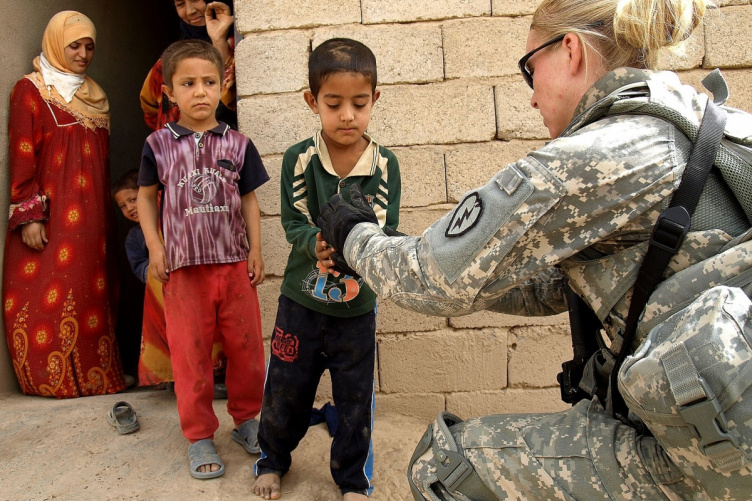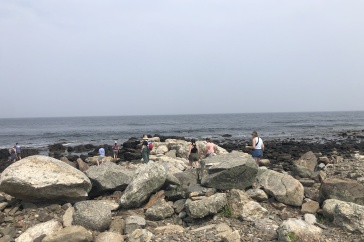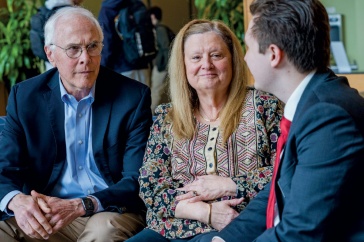
English instructor Nathan Webster knows what it is like to be on the frontlines. Not only did he serve in the 1991 Gulf War with the U.S. Army, but he's returned three times to the region — as a freelance photojournalist embedded with troops.
Webster says of his freelance work that he wanted to tell the stories not just of troops and military actions but also of the regular men and women fighting overseas.
"I originally set up my reporting trips because I felt it was important for individual soldiers to get coverage in local, smaller newspaper rather than non-specific national media ... so that there would be a personal face on the story," Webster says. "If a reader could see someone from their small town in their local newspaper, it might have more of an impact."
Webster '95 '09G is continuing his efforts to highlights soldiers' stories by helping to bring an exhibition of war photography to UNH's Dimond Library.
Conflict Zone is a traveling exhibit of today's leading international combat photojournalists' work, chronicling the scenes of war — the disturbing, heart-breaking and violent, but also the everyday interactions between soldiers and civilians, as well as images of soldiers' lives back home. Webster's own work is included in the show.
A formal opening will be held Thursday, Feb. 5 and will include an artist's walk-through with Webster. The exhibit will also include a reading and discussion with Elliot Ackerman, author of the upcoming novel Green on Blue, on Thursday, Feb. 26. Ackerman has written for The New Yorker and Daily Beast, and is a Marine veteran of Iraq and Afghanistan. The exhibit will remain open through March 6.
Webster believes it's important to keep the sacrifices soldiers and their families make in mind, especially for young adults, who have grown up in the post-911 War on Terror era.
"Even though the wars are 'over' we're still paying those costs today. When we see images of war, we usually see them on a computer screen. You might skim the story, click a couple of pictures, and then you click onto something else. It's important that UNH students have the opportunity to see these images in large-format style, which is much different than seeing them briefly on a digital screen," Webster says. "This exhibit eliminates distractions."
The exhibition includes photography by New York Times' Joao Silva, injured in Afghanistan, and the late Chris Hondros, killed during a freelance assignment in Libya (the exhibit is now dedicated to Hondros' memory). More than two dozen photographers are represented, with work spanning the last 13 years of conflict. It is a collection of images from both the frontlines of the wars in Iraq and Afghanistan, and the post-war homefront.
Webster, who has written extensively about his embedded experiences (and was referenced in Pulitzer Prize winner Tom Ricks' book The Gamble), contacted the organizers of Conflict Zone in 2011 to ask if his photos could be included in the exhibit.
"Now that I'm at UNH, I knew this would be an important exhibition to be displayed for the students here. And, since there was a UNH connection, we were able to make it happen!" Webster says.
Webster knows that some of the images are difficult to see, as they depict bloodshed and violence. But they are also a representation of the real experience of men and women in our armed forces — something the American public is aware of, but might not fully understand.
"It's not like people don't know about these conflicts but we might not really stop and think about it for any length of time. Knowing about something and really thinking about something are two different things," says Webster. "In whatever way the images speak to visitors, for a few minutes they will think about what they are seeing, and I think that's enough."
Want to Go?
What: Conflict Zone exhibit of war photography, funded by the Center for the Humanities, the UNH English Department and the University Museum.
Where: UNH's University Museum, Dimond Library, 18 Library Way, Durham, N.H.
When: The museum is open Monday-Friday, noon to 4 p.m., with extended hours of noon to 8 p.m. on Tuesdays.
Two Special Events: An opening reception Thursday, Feb. 5, from 5 to 6 p.m. Includes a walk-through with English instructor Nathan Webster, whose photographs are included in the exhibit. On Thursday, Feb. 26, Elliot Ackerman, author of the upcoming novel Green on Blue, will give a reading at the UNH Memorial Union Building, Theater II from 5 to 6 p.m.
Learn More: Want to talk to the exhibit's organizers, contact University Museum Curator Dale Valena at (603) 862-1081, or Nathan Webster, (603) 862-1313 or Nathan.Webster@UNH.edu.
-
Written By:
Michelle Morrissey ’97 | UNH Magazine | michelle.morrissey@unh.edu



















































